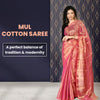The Timeless Elegance of Banarasi Sarees: A Legacy of Weaving Art

Banarasi sarees are more than just garments; they are a symbol of India’s rich cultural heritage, exquisite craftsmanship, and timeless elegance. Originating from Varanasi, these sarees have adorned women for centuries, making them an essential part of bridal trousseaus, festive wardrobes, and heirloom collections. Let’s delve into the fascinating world of Banarasi sarees and explore their history, types, craftsmanship, and enduring charm.
A Glimpse into History
The art of weaving Banarasi sarees dates back to the Mughal era, when Persian and Indian influences merged to create intricate designs. The Mughals introduced the art of brocade weaving using gold and silver threads, which later became the hallmark of Banarasi sarees. Over the centuries, the weavers of Varanasi have preserved this tradition, passing it down through generations, ensuring that each saree tells a story of artistry and dedication.
The Craftsmanship Behind Banarasi Sarees
Creating a Banarasi saree is a labor-intensive process that involves expert craftsmanship and dedication. The making of a single saree can take anywhere from a few weeks to several months, depending on the complexity of the design. The process includes:
- Selecting the Silk: The finest quality silk threads are chosen to ensure the saree’s longevity and sheen.
- Dyeing: The silk is dyed in vibrant colors using traditional methods to enhance its beauty.
- Weaving: Skilled artisans weave the saree using handlooms, incorporating intricate patterns with gold and silver zari threads.
- Embroidery: Many Banarasi sarees feature additional hand embroidery, adding more elegance and detail.
- Finishing Touches: The final product undergoes quality checks to ensure its perfection before reaching customers.
Other Exquisite Saree Varieties
While Banarasi silk sarees are the epitome of luxury, India boasts a rich diversity of handloom sarees, each with its unique charm:
- Khesh Saree: Originating from Bengal, these sarees are made by weaving old cotton fabrics into new designs, making them eco-friendly and artistic.
- Maheshwari Sarees: Hailing from Madhya Pradesh, these sarees feature a blend of silk and cotton, adorned with zari borders and intricate patterns.
- Mangalgiri Saree: A handwoven treasure from Andhra Pradesh, these sarees are known for their lightweight fabric and simple yet elegant zari borders.
- Linen Cotton Sarees: A perfect blend of linen and cotton, these sarees offer breathability and comfort, making them ideal for daily wear.
- Linen Silk Sarees: Combining the richness of silk and the softness of linen, these sarees exude understated elegance and sophistication.
- White Jamdani Saree: This traditional Bengali saree is woven with exquisite floral and geometric motifs, often in white-on-white patterns, giving it a regal appearance.
Jamdani Silk Saree: A luxurious variant of Jamdani sarees, these are crafted with fine silk and intricate handwoven motifs that reflect artistry and heritage.
Why Banarasi Sarees Are Special
Banarasi sarees are cherished for several reasons:
- Timeless Appeal: Their intricate craftsmanship and luxurious fabric make them a forever fashion statement.
- Symbol of Tradition: They are an integral part of Indian culture and heritage, often worn at weddings and festivals.
- Versatile Styling: From traditional draping to modern styling, Banarasi sarees can be worn in various ways.
- Heirloom Value: These sarees are often passed down through generations, carrying sentimental and historical significance.
Caring for Your Banarasi Saree
To maintain the beauty and longevity of your Banarasi saree, follow these care tips:
- Store it properly: Keep your saree in a muslin cloth to protect it from moisture and dust.
- Avoid direct sunlight: Prolonged exposure to sunlight can cause the colors to fade.
- Dry clean only: Professional cleaning ensures that the delicate fabric and zari work remain intact.
- Refold periodically: Change the folds occasionally to prevent creases and fabric stress.
Conclusion
Banarasi sarees are a timeless treasure, blending tradition with artistry. Whether you wear them for a wedding, festive occasion, or as an heirloom piece, these sarees are a testament to India's exquisite craftsmanship. Owning a Banarasi saree is not just about fashion; it is about embracing a piece of history, culture, and legacy that continues to thrive through generations.





